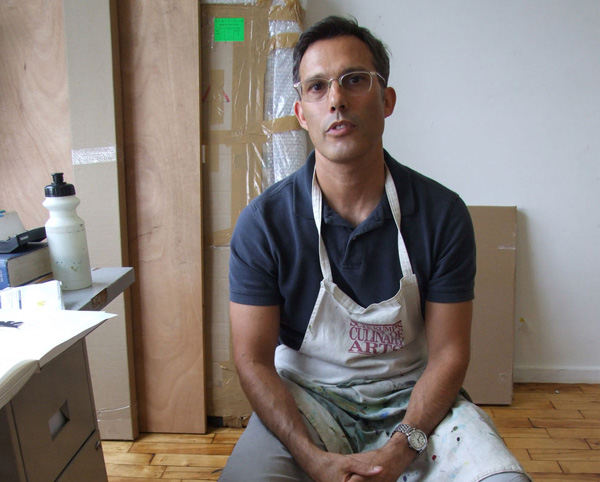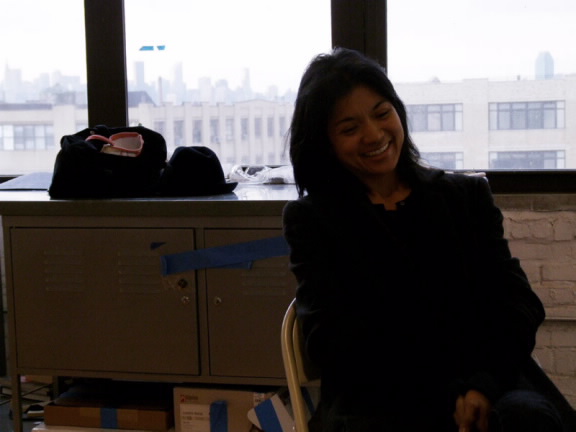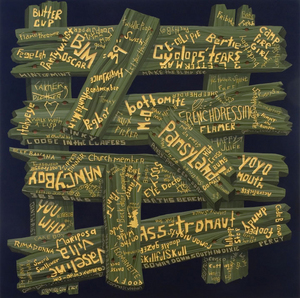This is an archive of the ArtCat Zine, 2007-2009. Please visit our new project, IDIOM.
Recently by Andrew Robinson
Michelle Lopez - The Violent Bear It Away
21 March - 17 May 2009 at Simon Preston Gallery
301 Broome Street
A conversation with artists Michelle Lopez and Andrew Cornell Robinson that took place in both of the artists’ studios in Bushwick, Brooklyn on 7 April 2009.
Andrew Cornell Robinson: When you went to California there was a shift in your work. In fact there seems to be several moments when your work has undergone significant shifts in attention and focus evidenced by the materials you use and your conceptual concerns.
Early on you started to work with leather, which became your signature material. Much of your work has had this intense exploration of material. What’s that about?
Michelle Lopez: Back in grad school, I was working with chocolate, and apple skins. I was trying to find a way to re-contextualize a material, something that was incredibly familiar to us. In a way the work is about how to invert something that is masculine and make it feminine, create this ambiguity. The thing that I am interested in most, is exploring androgyny. In terms of my education, I was interested in a feminist perspective, but I wasn’t really interested in a feminist aesthetic.
AR: What do you mean, like Judy Chicago?
ML: I was interested in feminist theory but not entirely convinced by the art, well yeah Judy Chicago, like all of the artists associated with early feminism.
ACR: A friend of mine calls that aesthetic “My Tortured Vagina” art.
ML: (Laughter) Exactly! So in a way I wanted to create work that was specifically non-gendered. For me it’s really hard to talk… I don’t want to be specific about the language. I feel like I can so easily get pinned down, and I don’t want to, so it’s better for me to keep the ideas open.

Steve DeFrank's new series of paintings in the exhibition Mirror, Mirror at Margaret Thatcher Projects plumb the depths of personal myth to reveal deceptively cheerful and malevolent emotions. His paintings depict a saccharine sweet caricatured naturalism rendering images of hidden sexual desire represented by images of degradation such as tree stumps and wooden boards riddled with carvings of phrases such as "Aunt Fancy" and "I Love Cum". The paintings are playful, but in a mischievous and subversive way and offer a significant departure for Defrank who had developed a signature body of work based on the format of the lite-brite toy. Steve and I had the opportunity to speak about his work shortly after the exhibition opened.
Andrew Cornell Robinson: You made a transition in your work. You moved away from your signature lite-brite compositions and created this incredibly series of paintings. Tell me about what was going on as you were going through this transition.
Steve DeFrank: I was doing the lite-brites, they were my gimmick, my shtick. It was beautiful, it gave me many gifts, and what I'd like to say is that my medicine finally kicked in.
ACR: You studied painting...
SD: I was trained as an academic painter. And that's what happened with the lite-brites. I studied at the Maryland Institute College of Art and then the School of Visual Arts.
ACR: I did too.
SD: You did not!
ACR: Did you have to draw those fucking plaster casts from the Parthenon at Maryland?
SD: Oh my god, yes!
ACR: When I was looking at your recent work I was struck by the attention to craft. And I don't mean that in a negative sense at all.
SD: I don't take it as that. In fact the lite-brites were doing the same thing. I was tinting my own lite-brite pins, and dotting those I's and crossing those T's. Craft is the same exact itch, it's just that the lite-brites became a gimmick, and there was no room left to grow after some time.
ACR: So you went through this radical change as an artist, and you did this in public. That must have been difficult. Think of all the flack that some one like Phillip Guston got when he made a radical shift from abstraction to painting objects and figures late in his life.
ZINE
HOME
TIPS / COMMENTS
CATEGORIES
CONTRIBUTORS
- Greg Afinogenov
- B. Blagojevic
- Adda Birnir
- Susannah Edelbaum
- Julie Fishkin
- Paddy Johnson
- Jessica Loudis
- Christopher Reiger
- Andrew Robinson
- Peter J. Russo
- Blythe Sheldon
- S.C.Squibb
- Hrag Vartanian


